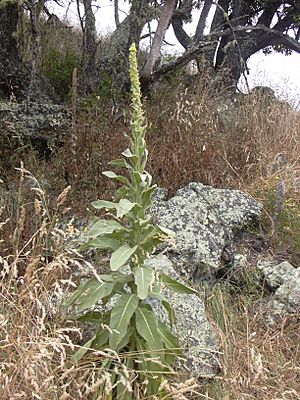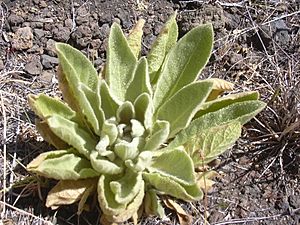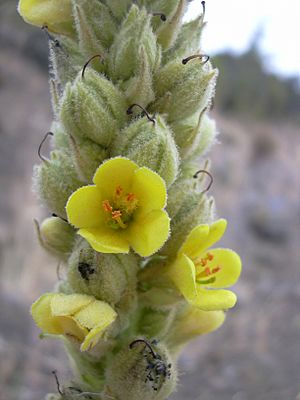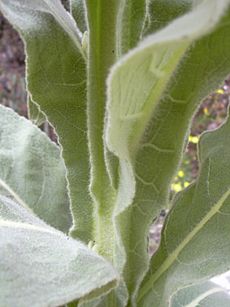Great mullein facts for kids
Quick facts for kids Great mullein |
|
|---|---|
 |
|
| Second-year plant starting to flower, with a dead stem of the previous year, behind left | |
| Scientific classification | |
| Genus: |
Verbascum
|
| Species: |
thapsus
|
The Great Mullein (also known as Common Mullein) is a tall plant with fuzzy leaves and bright yellow flowers. Its scientific name is Verbascum thapsus. This plant originally comes from Europe, northern Africa, and Asia. But now, you can find it in many other places like the Americas and Australia.
Great Mullein is a biennial plant, which means it lives for two years. In its first year, it grows a large, flat group of leaves close to the ground. In its second year, a tall stem shoots up, sometimes reaching over 2 meters (6 feet) high! Small yellow flowers grow tightly packed on this stem.
This plant can grow in many different places. It especially likes sunny spots with disturbed soil, like roadsides or fields. Its seeds can stay alive in the ground for a very long time. When the soil is disturbed and gets sunlight, the seeds can finally sprout. Great Mullein is a common weed because it makes so many seeds. It has become an invasive plant in some parts of the world. It's not usually a big problem for farm crops because it doesn't like shade from other plants. It also can't survive if the soil is tilled (turned over).
Even though people have used Great Mullein in traditional medicine, it is not an approved medicine. People have also used it to make dyes and even as torches.
Contents
What Does Great Mullein Look Like?

Great Mullein is a dicotyledonous plant, meaning its seeds have two parts. In its first year, it grows a rosette of large leaves. These leaves can be up to 50 centimeters (20 inches) long. In the second year, a single, tall stem usually grows from the center of the rosette. This stem is typically 1 to 2 meters (3 to 6.5 feet) tall.
The tall, pole-like stem has a dense spike of flowers at the top. This flower spike can take up half the stem's length. All parts of the plant, especially the leaves, are covered with soft, star-shaped hairs. These hairs make the leaves look silvery. The plant has 36 chromosomes.
The leaves on the flowering stem grow one after another. They are thick and attach to the stem in a special way called decurrent. The leaves change shape from the bottom to the top of the stem. They get smaller as they go higher up. The flowering stem is solid and about 2 to 2.5 centimeters (1 inch) wide. Sometimes, it might branch out if it gets damaged. After the flowers bloom and release their seeds, the stem and fruits dry up. They become dark brown, stiff structures with many small, dry seed capsules. These dried stems can last through winter and even into the next summer. The plant has a shallow taproot.
The flowers have five parts. They usually have five stamens (male parts) and a five-lobed calyx (outer leaf-like parts). The bright yellow corolla (petals) is 1.5 to 3 centimeters (0.6 to 1.2 inches) wide. The flowers are almost directly attached to the stem, with very short stalks.
The five stamens are different. The three upper stamens are shorter and have fuzzy filaments (stalks) with smaller anthers (pollen parts). The two lower stamens have smooth filaments and larger anthers. The plant produces small, oval-shaped capsules about 6 millimeters (0.24 inches) long. Each capsule splits open and contains many tiny, brown seeds. These seeds are less than 1 millimeter (0.04 inches) in size and have ridges. There is also a rare form of the plant with white flowers.
Great Mullein flowers for up to three months, from early to late summer (June to August in northern Europe). The flowers open from the bottom of the spike and move upward. Each flower only opens for part of a day, and only a few open at the same time around the stem.
Where Does Great Mullein Grow?
Great Mullein grows naturally across a large area. This includes Europe, northern Africa, and Asia. You can find it from the Azores and Canary Islands in the west, all the way to western China. It also grows north to the British Isles, Scandinavia, and Siberia, and south to the Himalayas. In northern Europe, it grows from sea level up to 1,850 meters (6,000 feet) high. In China, it grows even higher, at 1,400–3,200 meters (4,600–10,500 feet).
People have brought this plant to many other parts of the world where the climate is mild. It is now a common weed in places like Australia, New Zealand, tropical Asia, La Réunion, North America, Hawaii, Chile, Hispaniola, and Argentina. It has also been seen in Japan.
In the United States, Great Mullein was brought over in the early 1700s. People grew it for its medicinal uses and because it could be used to stun fish. By the early 1800s, it had spread so much that some people thought it was a native plant. Today, it is common in all U.S. states. In Canada, it is most common in the Maritime Provinces, southern Quebec, Ontario, and British Columbia.
Great Mullein grows best in bare, disturbed soil, especially sandy or chalky ground. It likes dry, sandy, or gravelly soils. However, it can grow in many different places, such as riverbanks, meadows, roadsides, forest clearings, and pastures. It can grow in so many different habitats because it can change its appearance a lot, not because it adapts to each place.
Life Cycle and Ecology
Great Mullein is a biennial plant, meaning it usually needs a cold winter rest before it can flower. This rest helps the plant store energy in its roots. Seeds mostly sprout in bare soil when temperatures are between 10°C and 40°C (50°F and 104°F). Even though some seeds can sprout in the dark, in nature, they usually only grow when exposed to light or very close to the soil surface. This explains why the plant likes open, disturbed areas. If it grows in bare soil, its first-year rosette grows four to seven times faster.
Seeds sprout in spring and summer. If seeds sprout in autumn, the plants will survive winter only if they are large enough (more than 15 cm or 6 inches wide). After flowering, the whole plant usually dies at the end of its second year. However, some plants, especially in colder areas, might need a third year to flower. If growing conditions are very good, some plants might even flower in their first year. Plants that live for three years produce fewer seeds than those that live for one or two years. While when a plant flowers and its size depend on the environment, most other features seem to be part of its genes.
Each flower on the Great Mullein spike is open for only one day. It opens before sunrise and closes in the afternoon. The flowers can self-pollinate if insects don't visit them. Many insects visit the flowers, but only some bees actually help with pollination. The Great Mullein flowers from June to August in most places, and sometimes into September or October in warmer areas. Bees and hoverflies are common visitors. The hairs on the lower stamens might help insects hold on.
The seeds of Great Mullein can stay alive and sprout for many decades, some studies say up to a hundred years! This plant makes a huge number of seeds. Each plant can produce hundreds of capsules, and each capsule can hold over 700 seeds. This means one plant can make up to 240,000 seeds in total! Because of this, the seeds stay in the soil seed bank for a long time. They can sprout from ground that looks bare, or soon after forest fires, long after the parent plants have died.
Great Mullein usually doesn't spread to new areas without help from humans. Its seeds don't travel very far on their own. Seed dispersion happens when the stem is moved by wind or animals. Most seeds (75%) fall within 1 meter (3 feet) of the parent plant, and 93% fall within 5 meters (16 feet).
Some bees, like those from the genus Anthidium, use the plant's fuzzy hairs to build their nests. The seeds are usually too small for most birds to eat, but the American goldfinch has been seen eating them. Other birds, like the Hawaiian goose and palila, eat the leaves or flowers. The white-headed woodpecker uses the plant to find insects. Deer and elk also eat the leaves.
Agricultural Impact and Control
Great Mullein is not considered a serious farm weed because it cannot compete with other plants that are already growing. It is easily pushed out by other crops, except in places where there isn't much other plant life, like some dry areas in California. In these places, it can take over from native herbs and grasses. When it appears after forest fires, it can also disrupt the natural plant growth cycle. Even though it's not a big threat to farms, it can be very hard to get rid of completely. It's especially a problem in pastures where animals have overgrazed. Great Mullein is listed as a noxious weed in Colorado and Hawaii in the U.S., and in Victoria, Australia.
Even though it's not a farm pest itself, Great Mullein can host many insects and diseases. Some of these insects are pests, but others are helpful. It can also carry plant diseases like the cucumber mosaic virus and powdery mildew. One study found that Great Mullein hosts insects from 29 different families. Common pests found on it include western flower thrips and tarnished plant bug. This means the plant can be a place for pests to stay during winter.
Other insects only eat Verbascum plants. These include mullein thrips and the mullein moth. Great Mullein also hosts helpful insects, like predatory mites and the minute pirate bug. Because it hosts both pests and helpful insects, Great Mullein can be useful for keeping stable populations of insects used to control pests in other crops.
If you want to control Great Mullein, the best way is to remove it by hand or with a hoe. After removing it, it's good to plant native plants in its place. Animals rarely graze on it because its hairs can be irritating. Liquid herbicides (weed killers) need special additives to work on Great Mullein. This is because the hairs make water roll off the plant, much like the lotus effect. Burning the plant doesn't work well because it just creates new bare areas for seeds to sprout. Some insects that eat mullein usually don't have a big effect on its overall population. Goats and chickens have also been suggested to help control mullein.
Uses of Great Mullein
It is said that Roman soldiers dipped the plant's stalks in grease to use them as torches. Other cultures used the leaves as wicks for lamps. Native Americans and early American colonists put mullein leaves in their shoes to keep their feet warm in the cold.
Great Mullein can be grown as an ornamental plant in gardens. Like many old plants, Great Mullein was sometimes linked to witches. However, it was also widely believed to protect against curses and evil spirits. The seeds of the plant contain chemicals that are toxic to fish. Because of this, they have been used to stun fish for fishing.
Because it spreads easily and can become a weed, Great Mullein is not often grown on purpose, unlike some other types of mullein.
Images for kids
See also
 In Spanish: Verbascum thapsus para niños
In Spanish: Verbascum thapsus para niños





